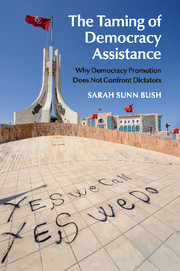Book contents
- Frontmatter
- Contents
- List of figures
- List of tables
- Preface
- List of abbreviations
- Part I Introduction and argument
- Part II Testing the argument
- 4 Delegation and the allocation of democracy assistance
- 5 Changes in American grant-making
- 6 Creating the democracy establishment
- 7 Jordan: aid in the shadow of geopolitics
- 8 Tunisia: reform after revolution
- Part III Conclusions
- Part IV Appendices and references
4 - Delegation and the allocation of democracy assistance
from Part II - Testing the argument
Published online by Cambridge University Press: 05 May 2015
- Frontmatter
- Contents
- List of figures
- List of tables
- Preface
- List of abbreviations
- Part I Introduction and argument
- Part II Testing the argument
- 4 Delegation and the allocation of democracy assistance
- 5 Changes in American grant-making
- 6 Creating the democracy establishment
- 7 Jordan: aid in the shadow of geopolitics
- 8 Tunisia: reform after revolution
- Part III Conclusions
- Part IV Appendices and references
Summary
Compare the cleanliness of your dining room and your attic. The dining room is observable to your dinner guest. The attic is not. Your dining room is a lot cleaner than your attic … If someone comes up with a utopian plan to transform your attic, nobody will ever know if it succeeded or not.
Western governments that seek to support democracy abroad have multiple instruments of foreign policy at their disposal. They can put diplomatic pressure on political elites in target countries, using the threats of economic sanctions or the rewards of foreign aid or international- organization membership to push for political reform. They can also directly intervene in other countries by funding democracy-assistance programs, attempting to amplify the voices of certain civil society groups, increase the capacity of democratic institutions, and improve the quality of elections. But the choice of instrument is not their only decision to make. When donor governments fund democracy assistance, they must also make choices about the channels through which to deliver the aid – choices about whether to pass aid through government agencies, non-governmental organizations of various nationalities, or multilateral organizations. This chapter focuses on those delegation decisions and their consequences for the design of the democracy-assistance programs that have been funded by twenty-three Western governments.
One of Chapter 2's central arguments was about how the preferences of organizations in the democracy establishment interact with the preferences of donor and target states. Those organizations sincerely care about advancing democracy in unfree countries. They also prefer to pursue tame democracy assistance, if possible, because doing so helps them survive and thrive as organizations. The more difficult it is for donors to observe and control organizations in the democracy establishment, the more those organizations will pursue tame programs, which help organizations signal effectiveness to distant donor officials and secure access to target states but which also involve tradeoffs in terms of democratization.
- Type
- Chapter
- Information
- The Taming of Democracy AssistanceWhy Democracy Promotion Does Not Confront Dictators, pp. 79 - 105Publisher: Cambridge University PressPrint publication year: 2015

